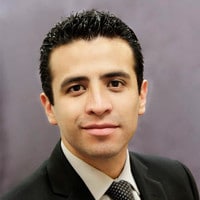At the 2019 Portada Event in Mexico City, we had an insightful Q&A session with Isaias Araiza, Manager, Destination Marketing LATAM at Hilton. He shares his know-how about destination marketing in Latin America, media mix, hotel sites vs. OTAs and more.
Interview conducted by Alejandra Velazquez
Destination Marketing: Tailoring the Message
In what ways are the Hilton advertising campaigns different for Latin America and for the rest of the world?

For Mexico and Colombia, it’s important not just to translate, but to adapt the message. You have to be very aware of the kind of words and ideas you are conveying, otherwise, your audience won’t feel connected. They are often very nationalistic and proud of their identity, and the communication needs to be respectful of that. We always cast talent that looks and feels Latin for local executions. Anna Kendrick is our global image, but if we featured her on Hispanic campaigns, people wouldn’t relate. You can’t just take it for granted. You need to speak their local language.
How about between Mexico and Colombia? Can the same message work for both?
The message and creativity can be the same. However, you have to pay attention to specific local language nuances. We’ve had issues with punctuation throughout Latin America. For example, many countries separate decimals with a comma, not a dot. So if we separate thousands with a dot, instead of three thousand pesos, it would end up looking like just three. We had to be meticulous with that. I always tell customers in the U.S. that they have to take into account the actual day-to-day grammar usage, not just what Google or the [Real Academia Española] says. We might even have legal problems if there’s a mix-up.
Hilton’s Media Strategy for Destination Marketing
What does your media mix look like in Mexico?
To promote destinations, we have an upper-funnel, massive media strategy. We’re trying to create brand awareness. Hilton is unequivocally recognized as a global hotel chain, however, its specialized portfolio brands are still not top-of-mind for audiences. For example, we want to make clear that Doubletree by Hilton is a part of our family. We still  conduct a great deal of offline traditional marketing: printed magazines, in-flight reading material, billboards, OOH at airports, digital and offline radio, and Spotify. Absolutely no television. A bit lower on the funnel, we have digital performance, targeting, training desk…, all things reach-media related. We target customers depending on the kind of hotel we try to promote.
conduct a great deal of offline traditional marketing: printed magazines, in-flight reading material, billboards, OOH at airports, digital and offline radio, and Spotify. Absolutely no television. A bit lower on the funnel, we have digital performance, targeting, training desk…, all things reach-media related. We target customers depending on the kind of hotel we try to promote.
How about your video content strategy?
We’re basing our contents around “Rediscover Mexico”, based on promoting the uniqueness of the destination. As of today, we have very little video content, but for this year we’ll be implementing a much stronger strategy. We need to capture customers during the “dreaming phase” and help them develop their journey through special offers. We’ll be offering two proposals: one focused on the destination and favorite places, and another with local stories and characters, influencers, experiences, and random tourist video tell-alls. Like, “tell me how everything was, what you did, where you stayed”, etc.
The Online Travel Agencies Controversy
Do you have a strategy to strengthen purchases on the hotel website vs. using OTAs as intermediaries? How do you fight the generalized idea that OTAs are much cheaper than buying directly at the hotel?
OTAs have spread the idea that their rates are cheaper, but that’s not true. Hilton has a strict parity policy, which means they offer the same rate on their website than anywhere else. This means a single rate anywhere online. There’s no way an OTA can offer a better rate. Expedia and other OTAs take a very significant cut out of the deal, but the price is the same for the general public. Of course, Hilton would prefer selling D2C.
A few years ago we launched a campaign called “Stop Clicking Around” and the motto was “don’t even look for a better rate, here’s the best offer you’ll find”. Same with the loyalty program. The only people who may get better rates than anyone else are the members of our Honor Program. Also, Hilton offers discounts and rewards for customers who purchase in advance. We have strong campaigns to fight OTA preference.
Is there a way to cut away from OTAs?
Maybe in the long run, but definitely not right now. Since they used to be the only online booking platform, the industry let them grow without limits and now they’re a necessary evil. They became a monster and we’re doing everything we can to control it, but the truth is… it does generate great volume. The problem is, a company should never earn much greater revenue from outside channels than from direct channels. The goal right now is not renouncing OTAs, but rather pairing the revenue mix to a much fairer amount. We’ll implement the strategy to get more flow into our home by generating content, launching informative campaigns, and fostering organic traffic to our sites.
Business VS Leisure
Could you give us cold hard numbers of the business vs. leisure categories for online purchases?
It’s hard to get precise data because Mexico is a very dynamic destination in terms of the business and leisure mix. For example, Hilton Reforma is for both sectors because of its privileged location. On weekdays it’s all about business, and during weekends it’s a leader of the plaza. Some hotels in Querétaro are really close to industrial parks and are purely for business, but we also offer benefits if you prolong your stay until the weekend. For example, all users may accumulate loyalty points by using hotel amenities, so they’ll end up redeeming them on future family trips. It’s almost impossible to get an average.
Marriott has a very strong minority inclusion program. Do you also have a competitive strategy?
We have an entire marketing section called Diversity and Inclusion, which covers all the spectrum: from commercial strategies to pricing, marketing, special offers, etc. We definitely offer special programs and rewards for our diverse program. Not doing it would be a mistake.
Learning From Mistakes
What was the mistake you learned from the most during your career?
I used to be a marketing director at one of our downtown Mexico City properties. We had a major issue with public protests and demonstrations. It was impossible not to address the issue. So we released campaign after campaign with alternative routes and all kinds of warnings. But instead of helping, it would highlight the problem. We spent too much time trying to solve it until we realized there was nothing we could do to soften the blow of traffic and blockades. We suffered several cancellations due to expecting an imminent protest, and in the end it wasn’t even as serious as it seemed. We’d live in fear and uncertainty.
Until we just accepted the issue instead of trying to cover it and we implemented a strike insurance: if your event had been in any way affected due to the circumstances, you got a discount. So instead of apologizing, we offered post-care. It’s all about the small details. For example, the Santa Fe DoubleTree offers a warm chocolate cookie upon check-in. We have customers married to the brand who come in just for that cookie. Every and any small thing you do for your customers counts.
Isaias Araiza, Manager Destination Marketing LATAM, Hilton will be one of the dozens of brand marketing innovators present at Portada Miami on June 4, 2020. If you are interested in participating in Portada Miami and/or in Portada’s networking and knowledge-sharing platform with brand marketers please contact us here.
[ctalatinb]







